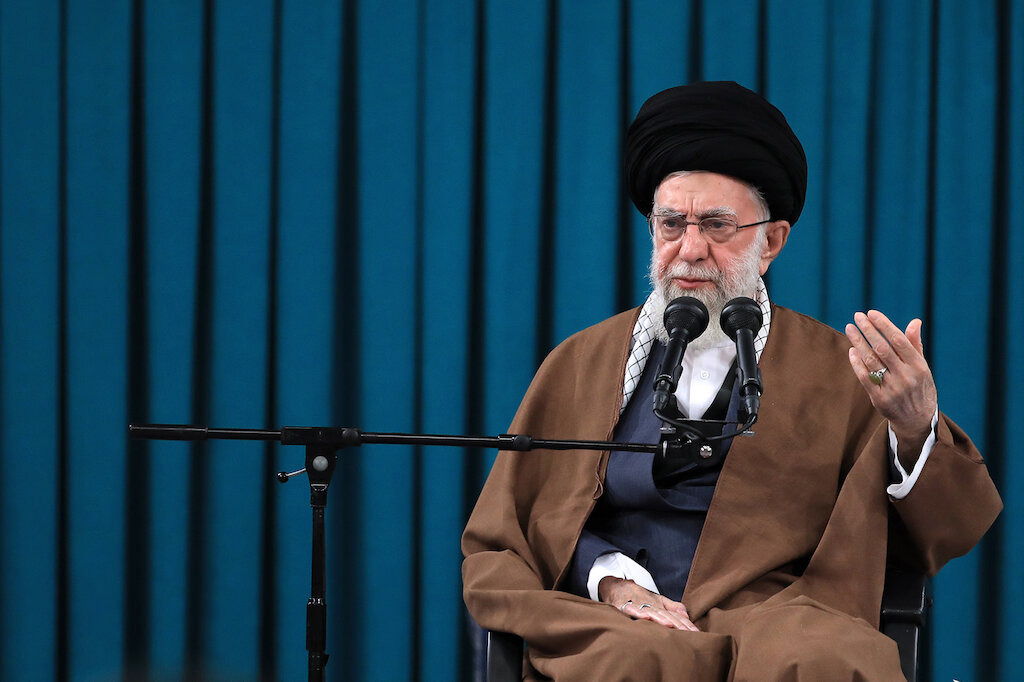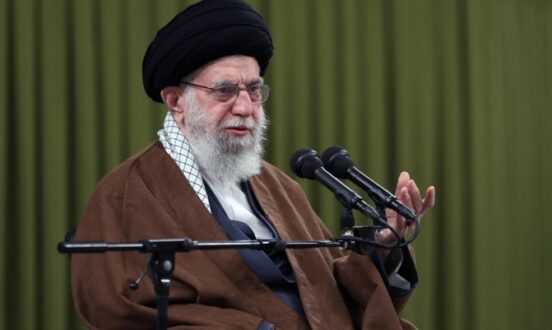gatestoneinstitute.org – It was supposed to be a routine remake of scores of reportages offered by the official TV each year. The formula used is simple: A concert hall filled with a handpicked audience of carefully screened audience chanting “God is Great, Hail to Supreme Leader!” Then the “Supreme Leader” enters, accompanied by his military and clerical entourage, to sit on high chair on an elevated platform facing the audience below from a distance of 10 meters.
As the cameras roll, the “Supreme Leader” repeats his shop-worn monologue about humbling the American “Great Satan” and wiping the “Zionist entity” from the face of the earth. He invites the young audience to prepare for martyrdom as a short-cut to a place in heaven in the next world. At the end of the ceremony, everyone shouts “Hail to the Chief” while the “Supreme Leader” exits the stage wearing a triumphal smile.
This month, however, the segment in the 34-year old soap opera didn’t go according to the script. To start with the audience, consisting of young recruits for the Baseej (Mobilization) militia, a key element in security, seemed hesitant to stand up as the chief arrived and, even worse, seemed parsimonious about shouting his adulation.
When the “Supreme Leader” developed an argument against consulting the people via a referendum, some in the young audience started to cackle and boo. Visibly taken by surprise, the chief mumbled, “We shouldn’t bang our heads against each other”. Then, as the booing continued albeit in a muffled form, he announced that the session was over and hastily headed for the exit.
The amazing extension of the cyberspace to Iran has had two crucial effects.
It has ended the government’s monopoly on sources of information and it has opened a window to the outside world which seems to live in another time-zone. Both those facts operate against a system that, struck by ideological atrophy, has failed to develop any mechanism for reform.
Today, the official TV is watched by less than 20 percent of Iranians while foreign-based satellite TV stations, beaming from Britain the United States, have secured audiences in virtually every corner of the country. Despite repeated efforts to shut the Internet, foreign based Persian-language TV stations claim audiences topping the million mark even for question-and-answer shows with Iranians spending a fortune on phone bills to express their grievances on live TV.
Another new fad is for young Iranians to wear the latest world-style clothes and accoutrements and take selfies for posting on social media. The idea is to show that many young Iranians, if not a majority, reject the one-size “Islamist” lifestyle that the regime has tried to impose for more than four decades.
International media have portrayed the current tension in Iranian society as a popular movement against the officially-imposed head-covering known as “hijab”. A closer look, however, shows that much more is at stake. With every day that passes, the number of women discarding the “hijab” grows while the mullahs wonder what to do.
Since the protests started almost six months ago, at least 600 people have been killed by security forces and a further 22,000 arrested, according to official figures.
What is going on is a cultural war between one world-view, propagated by Khomeinist ideologues, and another, defended by champions of what is called Iranism.
For Khomeinists, Iran is just a part of a global entity with a mission to spread the “true message” to every corner of the world. Dr. Hassan Abbasi, a leading theorist of Khomeinism and known as “Kissinger of Islam”, says Iran’s manifest destiny is to turn the White House in Washington into a Hussaynieh, ending American global hegemony. Iranian President Ebrahim Raisi talks of “burning Tel Aviv and Haifa to the ground.”
To young Iranists, Iran is a reality that transcends the Islamic part of its complex identity.
A series of opinion polls over the past three decades show that the American “Great Satan” is more popular in Iran than in France and Germany.

It was supposed to be a routine remake of scores of reportages offered by the official TV each year. The formula used is simple: A concert hall filled with a handpicked audience of carefully screened audience chanting “God is Great, Hail to Supreme Leader!” Then the “Supreme Leader” enters, accompanied by his military and clerical entourage, to sit on high chair on an elevated platform facing the audience below from a distance of 10 meters.
As the cameras roll, the “Supreme Leader” repeats his shop-worn monologue about humbling the American “Great Satan” and wiping the “Zionist entity” from the face of the earth. He invites the young audience to prepare for martyrdom as a short-cut to a place in heaven in the next world. At the end of the ceremony, everyone shouts “Hail to the Chief” while the “Supreme Leader” exits the stage wearing a triumphal smile.
This month, however, the segment in the 34-year old soap opera didn’t go according to the script. To start with the audience, consisting of young recruits for the Baseej (Mobilization) militia, a key element in security, seemed hesitant to stand up as the chief arrived and, even worse, seemed parsimonious about shouting his adulation.
Even then, worse was to come.
When the “Supreme Leader” developed an argument against consulting the people via a referendum, some in the young audience started to cackle and boo. Visibly taken by surprise, the chief mumbled, “We shouldn’t bang our heads against each other”. Then, as the booing continued albeit in a muffled form, he announced that the session was over and hastily headed for the exit.
The amazing scene, broadcast live, was later removed from official websites but not without marking a new phase in a clash between a new generation of Iranians and the gerontocracy headed by Grand Ayatollah Ali Khamenei.
Over 50 million of Iran’s population of 87 million had not been born when the mullahs seized power in 1979. A further 10 million were children or adolescents who feel alien in a world imagined by ageing mullahs that seem to belong to another age if not another planet.
The amazing extension of the cyberspace to Iran has had two crucial effects.
It has ended the government’s monopoly on sources of information and it has opened a window to the outside world which seems to live in another time-zone. Both those facts operate against a system that, struck by ideological atrophy, has failed to develop any mechanism for reform.
Today, the official TV is watched by less than 20 percent of Iranians while foreign-based satellite TV stations, beaming from Britain the United States, have secured audiences in virtually every corner of the country. Despite repeated efforts to shut the Internet, foreign based Persian-language TV stations claim audiences topping the million mark even for question-and-answer shows with Iranians spending a fortune on phone bills to express their grievances on live TV.
But that is not all. Thanks to access to cyberspace, some Iranian influencers have secured huge audiences. Young girls with Twitter or Instagram accounts reach more people than does the “Supreme Leader” through his hugely costly official media.
Popular musicians attract much larger audiences than official reciters of the holy text or preachers paid by the government. A simple song by the young pop-star Sherwin Hajipour has morphed into an alternative national hymn, edging away the 44-year anthem composed in praise of Imam Khomeini. The popular poet-composer Shahin Najafi’s latest single “Shah” is reported to have sold more than a million copies in a few weeks.
The new image of Iran emerging in cyberspace finds echoes in real life. In the latest Iranian New Year holidays, in March, ancient Iranian sites such as Persepolis, capital of the Achaemenid Empire and Pasargadae where Cyrus the Great is buried, topped the list of most visited places in the country. According to official figures from the Ministry of Guidance and Tourism, the mausoleums of poets, such as Sa’adi and Hafez, attracted more visitors than the Mausoleum of the 8th Imam in Mashhad.
Another new fad is for young Iranians to wear the latest world-style clothes and accoutrements and take selfies for posting on social media. The idea is to show that many young Iranians, if not a majority, reject the one-size “Islamist” lifestyle that the regime has tried to impose for more than four decades. “We live in the 21st century,” a young girl from a small coastal town said in a recent live TV phone-in program. “All we ask is to let us decide for ourselves what we wear and how we live without harming anyone.”
International media have portrayed the current tension in Iranian society as a popular movement against the officially-imposed head-covering known as “hijab”. A closer look, however, shows that much more is at stake. With every day that passes, the number of women discarding the “hijab” grows while the mullahs wonder what to do.
Since the protests started almost six months ago, at least 600 people have been killed by security forces and a further 22,000 arrested, according to official figures.
What is going on is a cultural war between one world-view, propagated by Khomeinist ideologues, and another, defended by champions of what is called Iranism.
For Khomeinists, Iran is just a part of a global entity with a mission to spread the “true message” to every corner of the world. Dr. Hassan Abbasi, a leading theorist of Khomeinism and known as “Kissinger of Islam”, says Iran’s manifest destiny is to turn the White House in Washington into a Hussaynieh, ending American global hegemony. Iranian President Ebrahim Raisi talks of “burning Tel Aviv and Haifa to the ground.”
To young Iranists, Iran is a reality that transcends the Islamic part of its complex identity. Iran is the whole, while Islam in its Khomeinist version only a part.
A series of opinion polls over the past three decades show that the American “Great Satan” is more popular in Iran than in France and Germany.
Suddenly all things Iranian are keenly appreciated. Classic literary texts are re-edited, reaching readerships seldom seen before. Traditional architecture, music, art and even cuisine are reasserting their presence as elements of the resurgent Iranian identity.
The current duel between Khomeinist mullahs and a new generation of Iranians reminds one of the Kulturkampf (Culture War) that Germany experienced in the 19th century when “re-becoming ourselves” meant upholding the German identity, while the Catholic Church preached communion through Christianity.
That war was won by Germanists. We shall see if Iranists win this one in Iran.
Amir Taheri was the executive editor-in-chief of the daily Kayhan in Iran from 1972 to 1979. He has worked at or written for innumerable publications, published eleven books, and has been a columnist for Asharq Al-Awsat since 1987. He is the Chairman of Gatestone Europe.
This article originally appeared in Asharq Al-Awsat and is reprinted by kind permission of the author.
 Shabtabnews In this dark night, I have lost my way – Arise from a corner, oh you the star of guidance.
Shabtabnews In this dark night, I have lost my way – Arise from a corner, oh you the star of guidance.



